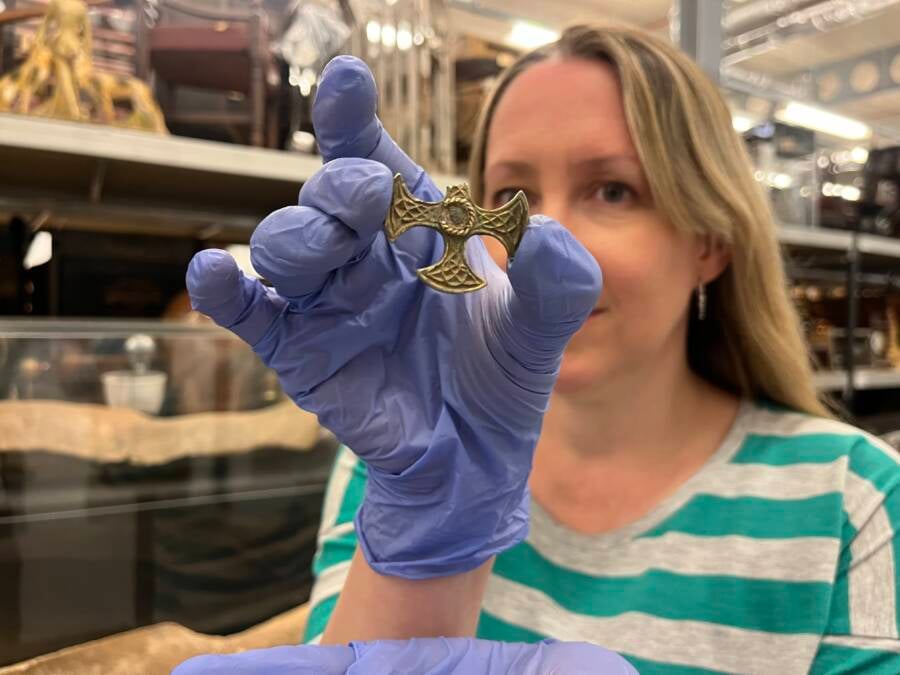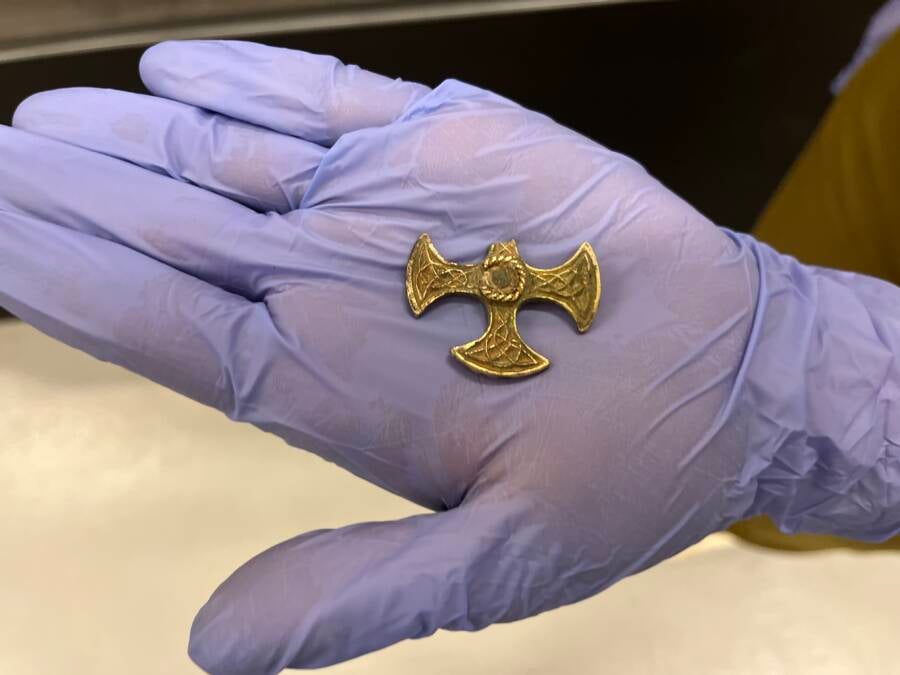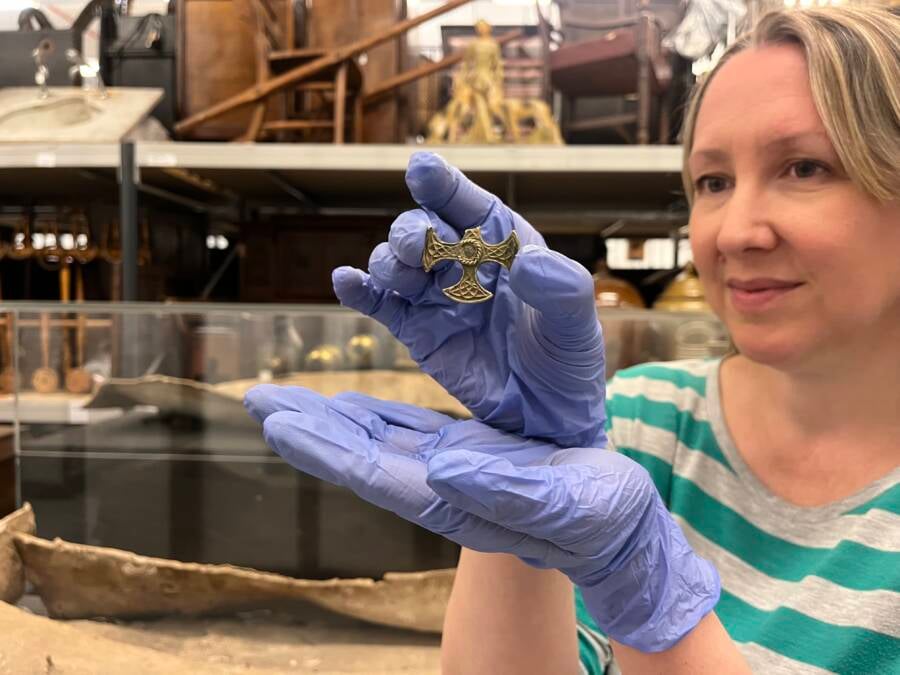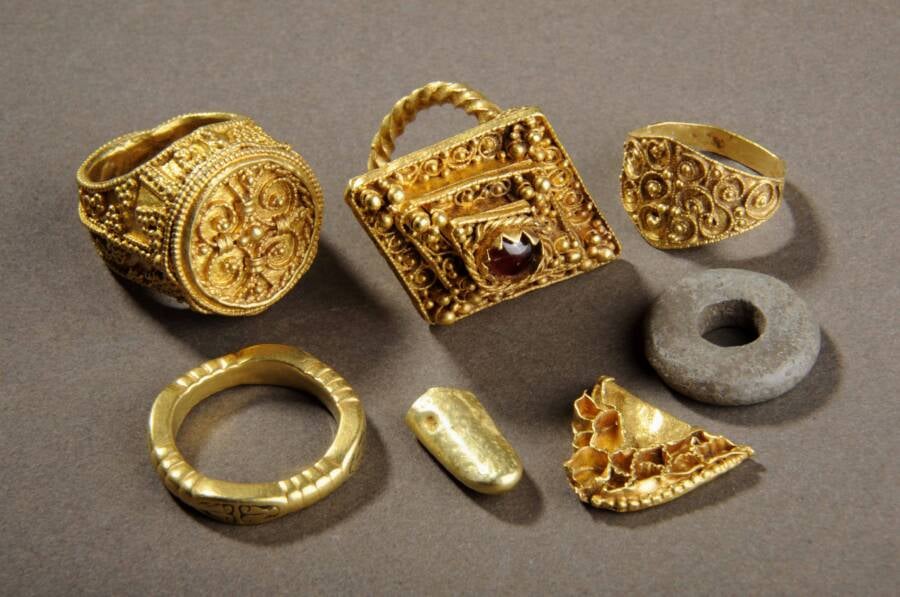A metal detectorist surveying a field in Leeds, England recently happened upon a medieval Saxon pendant covered in gold leaf and dating back to the 8th century C.E.

Leeds City CouncilThis medieval Saxon pendant unearthed by a metal detectorist in Leeds is more than 1,000 years old.
Last year, a metal detectorist stumbled upon a tiny treasure in Leeds, England. While scouring a local field, they came across a cross-shaped pendant, which experts say dates back to the 8th century C.E.
This gilded cross likely once belonged to a church official, though its origins otherwise remain mysterious. And it’s not the only centuries-old treasure that metal detectorists have turned up in Leeds.
The Discovery Of A 1,200-Year-Old Saxon Pendant By A Metal Detectorist In Leeds

Leeds City CouncilThe pendant is painted with a thin layer of gold leaf, and decorated with an “intricate interlacing Saxon pattern.”
According to a press release from the Leeds City Council, the cross-shaped pendant was uncovered in 2024 by a metal detectorist in Leeds. Made of solid silver, this stunning 1,200-year-old pendant is painted with a thin layer of gold leaf and engraved with an “intricate interlacing Saxon pattern.” Though one arm of the cross has broken off, what remains of the pendant is in remarkably good condition.
Experts believe that this medieval relic was probably a “badge of office” worn by an important church leader or official.
“The cross is beautifully decorated on both sides, which suggests it was designed to hang around the neck with the suspension loop on the missing arm,” Kat Baxter, Leeds Museums and Galleries’ curator of archaeology, explained in the press release. “It would certainly have been worn by someone of high status and is an outward display of religious identity.”
This cross pendant is an especially exciting find because it dates back to the eighth century, a pivotal era in Leeds’ history. It was then that the earliest known reference to Leeds (or Loidis) was made by the famous monk and historian The Venerable Bede. Leeds was then part of the Saxon Kingdom of Northumbria, one of several kingdoms in England that were united by Athelstan, the first king of all of England, in the 10th century.

Leeds City CouncilThis cross pendant dates back to the eighth century C.E., an important era in Leeds’ history.
“[The pendant] was made at a time when Leeds was part of the Saxon Kingdom of Northumbria and, along with a number of other discoveries in the area, really helps us build a picture of the types of people who would have lived here during this time,” Baxter remarked.
And while this cross pendant is an exciting discovery, it’s just the latest historic artifact found in Leeds in recent years.
The Wealth Of Saxon And Roman Relics Unearthed In Leeds
As the Leeds City Council notes, the cross pendant is one of many Saxon and Roman objects that have been unearthed here in recent years, both by metal detectorists and professional archaeologists.
In 2012, the Leeds Museums and Galleries acquired the “West Yorkshire Hoard,” seven objects from between the seventh and 11th centuries that were found by a metal detectorist. Five of the seven objects are high-quality gold jewelry which, according to the Leeds City Council, “would only have been worn by people of exceptional wealth in Saxon society.”

Leeds City CouncilThe West Yorkshire Hoard, which was found in 2012 and includes opulent gold jewelry once worn by elites centuries ago.
In 2023, a 1,600-year-old lead coffin was found at a previously unknown cemetery, alongside the remains of 60 individuals from late Roman to early Saxon periods. Inside the coffin, archaeologists found a woman who had died between the ages of 25 and 35 and was buried wearing a bracelet, a glass bead necklace, and what appeared to be a finger ring or earring.
According to Baxter, finds like these — and more recent finds like the gilded cross pendant — are important parts of Leeds’ history.
“All of these finds are part of a puzzle which together show that Leeds was home to high status, important individuals during the Saxon period, and this beautiful cross is the latest glimpse into the past,” she said. “Unfortunately, objects representing less wealthy people are less likely to survive.”
Baxter believes that there are “certainly more objects out there waiting to be discovered” and that “responsible metal detectorists” play an important role in “increasing our understanding of local history.”
Indeed, in a place like Leeds, metal detectorists have a fairly good chance of stumbling upon historic treasures from the area’s distant past.
After reading about the 1,200-year-old gilded Saxon pendant that was found by a metal detectorist, go inside the enduring mystery of who built Stonehenge. Then, learn about Aethelred the Unready, the English king who — despite his name — became the longest-ruling English monarch of the Anglo-Saxon era.





